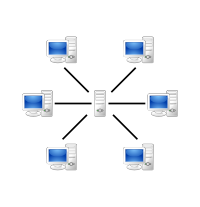Peer-to-peer
A
peer-to-peer (P2P) network is a type of decentralized and distributed network architecture in which individual nodes in the network (called
"peers") act as both suppliers and consumers of resources, in contrast to the centralized client–server model where client nodes request access to resources provided by central servers.
In a peer-to-peer network, tasks (such as searching for files or streaming audio/video) are shared amongst multiple interconnected peers who each make a portion of their resources (such as processing power, disk storage or network bandwidth) directly available to other network participants, without the need for centralized coordination by servers.
A
peer-to-peer (P2P) network in which interconnected nodes ("peers") share resources amongst each other without the use of a centralized administrative system:

A network based on the
client-server model, where individual
clients request services and resources from centralized servers
 Architecture of peer-to-peer systems
Architecture of peer-to-peer systemsA peer-to-peer network is designed around the notion of equal
peer nodes simultaneously functioning as both "clients" and "servers" to the other nodes on the network. This model of network arrangement differs from the client–server model where communication is usually to and from a central server. A typical example of a file transfer that uses the client-server model is the File Transfer Protocol (FTP) service in which the client and server programs are distinct: the clients initiate the transfer, and the servers satisfy these requests.
Routing and resource discoveryPeer-to-peer networks generally implement some form of virtual overlay network on top of the physical network topology, where the nodes in the overlay form a
subset of the nodes in the physical network. Data is still exchanged directly over the underlying
TCP/IP network, but at the application layer peers are able to communicate with each other directly, via the logical overlay links (each of which corresponds to a path through the underlying physical network). Overlays are used for indexing and peer discovery, and make the P2P system independent from the physical network topology. Based on how the nodes are linked to each other within the overlay network, and how resources are indexed and located, we can classify networks as
unstructured or
structured (or as a hybrid between the two).
--
Ref:
http://en.wikipedia.org/wiki/Peer-to-peer#cite_note-1